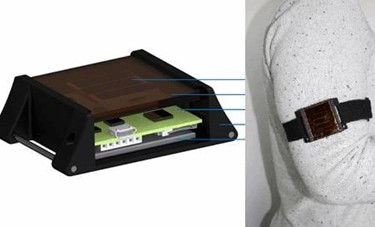First Real-Life Study Tests Feasibility Of Solar-Powered Implants

Researchers in Switzerland have produced real-life evidence that implanted devices could one day be powered by solar energy. Study participants who wore solar power measurement devices throughout their regular daily activities generated the energy required to power the average contemporary pacemaker, regardless of the weather, season, or age.
Advancements in implant technology are dependent on possible power sources — in most cases a battery, which can influence the size of the implant and where it can be placed. Batteries must be big enough to power a device long-term, and even the most advanced battery technology will require surgical replacement eventually, exposing the patient to additional risk. Researchers in pursuit of battery-free technology have recently suggested piezoelectric harvesting systems, such as pacemaker technology that can collect energy from the patient’s own heartbeat.
According to scientists at the Bern University Hospital and University of Bern in Switzerland, researchers have begun exploring the possibility of solar-powered implants, but until now, no real-life evidence existed to prove the idea’s feasibility. These researchers set out to test the idea and published their results in the Annals of Biomedical Engineering.
Swiss mathematicians determined that the average implanted device would require a solar cell measuring 3.6 square centimeters. Researchers constructed a corresponding wearable device featuring solar cells and a measurement system that could monitor power output. Optical filters fitted over the device mimicked properties of the skin and demonstrate capabilities of subcutaneously implanted solar cells.
Thirty-two trial participants between the ages of 18 and 64 were instructed to wear the measurement device for one week per season in the summer, autumn and winter and make daily notes about weather conditions and their activities. Their research demonstrated that solar cells could collect more than enough energy to power implanted devices, even during darker days and weather.
“In every season, the measured average power is multiple times higher than the power consumption of contemporary cardiac pacemakers (5-10 according to the device manufacturer’s reference manuals),” wrote authors of a study led by Lukas Bereuter. “The participant with the lowest power still obtained 12 when considered the mean over every season.”
Study authors noted that additional features, such as an accumulator, could collect extraneous power during peak hours or months and use the energy to power the device when the patient has less or no access to the sun, as is the case in Nordic countries.
Scientists also acknowledged that their optical filter mimicked the sun absorption of Caucasian skin and results may vary for patients with darker skin tones. Additional factors such as hair length, skin thickness, and clothing could also affect results.
Though the study focused on the power needs of a pacemaker, Bereuter commented in a press release that the technology and study could easily be adjusted to suit the power needs of other devices, such as spinal cord stimulators.
“The overall mean power obtained is enough to completely power, for example, a pacemaker or at least extend the lifespan of any other active implant,” noted Bereuter in a press release. “By using energy-harvesting devices such as solar cells to power an implant, device replacements may be avoided and the device size may be reduced dramatically.”
